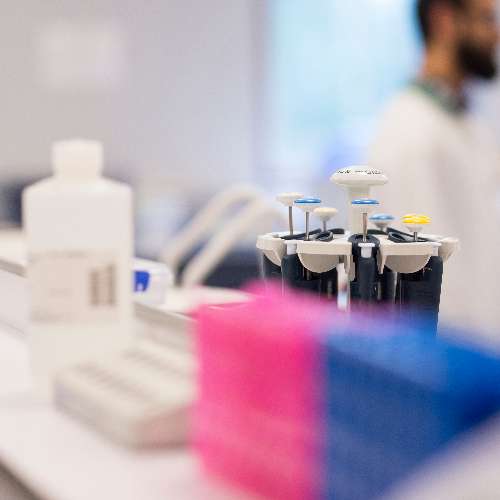We offer MSc by research degrees, whereby the student carries out a research project for a full year in a member of staff’s research group.
This is an increasingly popular option for students who prefer to gain extensive experience in laboratory (or in some cases computational biology) research, as preparation for a PhD application or a career in the biotechnology or health sciences research areas. The number of students taking up the project opportunities on offer in the School have steadily increased in recent years.
Direct link to apply for:
MSc by Research in Genetics:
MSc by Research in Cell Biology:
MSc by Research in Biochemistry:
MSc by Research in Microbiology
Msc by Research in Computational Biology:
Projects available for September 2020:
all listed projects will incur additional research costs of £1500
Cancer and Ageing
- Supramolecular Self-associating Amphiphiles (SSAs) for the treatment of cancer
- Towards the biological degradation of plastic materials
- Genes, health, disease and ageing: a data science approach
- Understanding how RNA Polymerase III acts to promote longevity and health
- Eating and Sleeping: Understanding how SKN-1/Nrf acts in the nervous system to promote satiety
- Live strong and healthy – Understanding the links between the microbiome, muscle function and healthy ageing
- Effects of host-microbiome interactions on the ageing nervous system
- Mechanical signaling mis-regulation in metastasis
- The roles of RAS in controlling cell fate – a yeast model of oncogenic potential
- Investigating the role of mitochondria in regulating cell health and ageing
- Investigating the determinants of SARS Coronavirus-2 pathogenicity
- Predicting protein function
- Investigating determinants of virus pathogenicity
- Investigation of drug-adapted cancer cell lines
- Evolution of the muscle sarcomere. A bioinformatics approach to the interaction between myosin and myosin binding protein-C
- Using cancer genomics to identify biomarkers of cancer resistance
- Age-related changes in the gut: more than just a gut feeling?
- Correcting the code of life
- Investigating the role of APOBEC3 enzymes in acquired resistance to chemotherapy drugs
- Exploring a role for APOBEC3 genes in mammalian evolution
Cellular Architecture and Dynamics
- How does phosphorylation of a molecular-motor regulate cellular growth?
- Bubbling at the surface”: Generating vesicles to enhance recombinant protein production and storage
- Probing the mechanism of INDY (I’m not dead yet) transporters: a target for the treatment of cancer, diabetes and obesity
- The path to least resistance: probing the mechanism of integral membrane transport proteins essential for antimicrobial resistance in bacteria
- New Approaches to Rapid Protein Structure Determination by NMR
- Deciphering the talin code – a cellular code that enables cells to feel their environment
- Wiring the brain – deciphering how neurons make the right connections
- In-cell structural biology: CLIC1 structure, function and drug binding inside tumour cells
- Understanding antimicrobial activity in live cells
- Engineering proteins for the production of antimicrobial peptides
- Investigating the molecular basis of human heart disease using cutting-edge imaging
- Integrative atomic force microscopy for structural analysis of bio-molecules
- Structural biology of amyloid aggregates
- Synthetic biology approach to self-assembled fibrous bio-materials
- Computational structural biology of filamentous disease associated amyloid assemblies
Industrial Biotechnology
- Generation of Coronavirus protein antigens for development of diagnostics and novel vaccine approaches
- Engineering of Mammalian Cells for Enhanced Biotherapeutic Protein and Gene Therapy Production
- Biofuels: could the yeast Scheffersomyces stipitis help?
- Towards quinine analogs for novel Covid-19 (SARS-CoV-2) therapeutics
-
Synthetic biology refactoring of an anti-tumour drug from a deep-sea marine bacteria
-
Cell-free biosynthesis of xenobiotics
- Investigating the biosynthesis of the unusual base, DMB
- Vitamin analogues as probes and imaging agents
- Vitamin B12 forms a pact to cure cancer
Infectious Diseases
- The CydDC transporter of E. coli: biochemical characterisation of an antimicrobial target
- Investigating the effect of both symptomatic and asymptomatic COVID-19 infections in the diversity of the human gut microbiome
- Using Caenorhabditis elegans as a model to explore the pathogenic role(s) of microbial gut parasites
- Exploring Cryptosporidium transportome and how it affects the intracellular interactions with its host
- Exploring the eukaryotic gut microbiome among animals
- Elucidating the role of the host environment in controlling the fungal-host pathogen interaction
- Investigating the role of polymicrobial interactions in antimicrobial resistance
- Exploring the potential use of bacteria to kill fungal pathogens
Evolution, Reproduction and Genome Organisation (ERGO)
- Using CRISPR-Cas9 to shuffle the Candida albicans genome
- Investigating the adaptation of South Asian cattle breeds to extreme climates – can we identify genomic regions responsible for these traits?
- The role of APOBEC3 genes: from cancer to mammalian genome evolution
- How does wrongful expression of germline genes drive HPV cancer pathology
- Are Y-linked genes the explanation for the differential prevalence of certain cancers between men and women?

